Thursday, April 14, 1966
Recording "Paperback Writer", "Rain"
For The Beatles
Last updated on December 18, 2023
Thursday, April 14, 1966
For The Beatles
Last updated on December 18, 2023
April 6 - June 22, 1966 • Songs recorded during this session appear on Revolver (UK Mono)
Recording studio: EMI Studios, Studio Three, Abbey Road
Session Apr 11, 1966 • Recording "Got To Get You Into My Life", "Love You To"
Session Apr 13, 1966 • Recording "Love You To", "Paperback Writer"
Session Apr 14, 1966 • Recording "Paperback Writer", "Rain"
Session Apr 16, 1966 • Recording "Rain"
Some of the songs worked on during this session were first released on the "Paperback Writer / Rain (UK)" 7" Single.
This was the sixth day of the recording sessions for the “Revolver” album. Time was spent recording “Paperback Writer” and “Rain“, two songs which would not appear on “Revolver” but would be released as The Beatles’ next single.
The session was attended by Leslie Bryce, a photographer from the Beatles Monthly Book.
From 2:30 pm to 7:30 pm, The Beatles completed the recording of “Paperback Writer“. The basic track (take 2) had been recorded the previous day, and time was spent adding overdubs. Those were documented by second engineer Phil McDonald, and his notes reproduced in The Complete Beatles Recording Sessions by Mark Lewisohn, 2004.
Among those overdubs, Paul McCartney added his bass part, double-tracked his vocals and added some backing vocals along with John Lennon and George Harrison. George Martin also recorded some piano and organ parts, which didn’t make it in the final mix of the song.
Paul’s bass part was recorded by engineer Geoff Emerick using a new “speaker as a microphone” technique:
[…] Paul turned to me. “Geoff,” he began, “I need you to put your thinking cap on. This song is really calling out for that deep Motown bass sound we’ve been talking about, so I want you to pull out all the stops this time. All right, then?”
I nodded an affirmative. Paul had long been complaining that the bass on Beatles records wasn’t as loud or as full as the bass on the American records he so loved. He and I would often get together in the mastering room to listen intently to the low end of some new import he had gotten from the States, most often a Motown track. Even though we had DI (Direct Inject) boxes available, I rarely used them to record Paul’s bass — I still don’t, as a matter of fact. Instead, I followed the standard EMI directive of placing a microphone in front of his bass amplifier. The bass sounds we were getting were decent — partly because Paul had switched from his signature Hofner violin “Beatle” bass to a beefier Rickenbacker — but still not as good as what we were hearing on those American records.
Fortunately, as Paul and John turned to George Harrison and began showing him the chords to “Paperback Writer,” inspiration struck. It occurred to me that since microphones are in fact simply loudspeakers wired in reverse (in technical terms, both are transducers that convert sound waves to electrical signals, and vice versa), why not try using a loudspeaker as a microphone? Logically, it seemed that whatever can push bass signal out can also take it in — and that a large loudspeaker should be able to respond to low frequencies better than a small microphone. The more I thought about it, the more it made sense.
I broached my plan, gingerly, to Phil McDonald. His response was somewhat predictable: “You’re daft; you’ve completely gone around the twist.” Ignoring him, I took a walk down the hall and talked it over with Ken Townsend, our maintenance engineer. He thought my idea had some merit.
“Sounds plausible,” he said. “Let’s wire a speaker up that way and try it.” Over the next few hours, while the boys rehearsed with George Martin, Ken and I conducted a few experiments. To my delight, the idea of using a speaker as a microphone seemed to work pretty well. Even though it didn’t deliver a lot of signal and was kind of muffled, I was able to achieve a good bass sound by placing it up against the grille of a bass amplifier, speaker to speaker, and then routing the signal through a complicated setup of compressors and filters—including one huge experimental unit that I secretly borrowed from the office of Mr. Cook, the manager of the maintenance department.
With renewed confidence, I returned to the studio to try it out for real. Paul wasn’t as nontechnical as John, but this was pretty way out, even by Beatles standards. He looked at me in a funny way as I set up the big, bulky loudspeaker in front of his amp instead of the usual microphone, but he didn’t say anything, and neither did George Martin, who by now was getting used to my Rube Goldberg approach to recording. They returned their attention to the rehearsals, giving me the opportunity to cautiously raise the fader carrying the bass signal. Paul’s distinctively fluid bass line in “Paperback Writer” consisted mostly of notes played high up on the lowest strings, which helped round out the tone further still. It sounded absolutely huge, so much so that I became somewhat concerned that it might actually make the needle jump out of the groove when it was finally cut to vinyl. But Paul loved the sound, and it was eventually left to my mate Tony Clark to cut the master lacquer. I was glad Tony had gotten the assignment, and he did a brilliant job. If it had been one of the older guys, they would have either slashed all the bass out of it, or sent it back and told us to mix it again.
Geoff Emerick – From “Here, There and Everywhere: My Life Recording the Music of The Beatles“, 2006
I thought, “Why not use a big EMI loudspeaker as a microphone and feed it backwards?” The speaker we used was one of the big white ones we used to call “White Elephants.” We positioned it directly in front of the bass speaker and the moving diaphragm of the second speaker made the electric current. I just fed it straight out into the Microphone Input of the mixing console. It got you fantastic bass, but it picked up everything in the building as well!
Ken Townsend – Engineer at EMI – From “Revolver (2022)” book
The heavier bass on The Beatles’ records from 1966 onwards can also be partly attributed to an invention called ATOC (Automatic Transient Overload Control).
In the cutting room, we put an advanced head on the playback tape machine that looked at the signal well in advance of the second head. The first head decided how much groove spacing there would be, so that if there were going to be some very high transients coming through then the grooves would be spaced wider at that particular point. It anticipated what was coming.
Ken Townsend – Engineer at EMI – From “Revolver (2022)” book
[Paperback Writer was] EMI’s first high-level cut. ATOC was a huge box with flashing lights and what looked like the eye of Cyclops staring out at you. I did two cuts, one with ATOC and one without, played them to George Martin and he approved of the high-level one.
Tony Clarke – Engineer at EMI – From “Revolver (2022)” book
The mono version released on the single (Remix Mono 2) was mixed on this day. The stereo version would be mixed on October 31, 1966, to be released on the compilation “Collection of Oldies“.
After a 1-hour break, The Beatles returned to work at 8:30 pm, and till 1:30 am, started working on “Rain“, the B-side of their next single (“Paperback Writer” being the A-side).
Five takes of the rhythm track were recorded with John Lennon and George Harrison on electric guitars, and Ringo Starr on drums, according to “The Beatles Recording Reference Manual – Volume 2 – Help! through Revolver (1965-1966)” by Jerry Hammack. In the “Revolver (2022)” book, it is reported Paul McCartney played electric guitar, instead of George.
Take 5 was deemed the best, and John overdubbed his lead vocals onto it while George added another guitar part.
One of the things we discovered when playing around with loops on ‘Tomorrow Never Knows’ was that the texture and depth of certain instruments sounded really good when slowed down. With ‘Rain’ the Beatles played the rhythm track really fast so that when the tape was played back at normal speed everything would be so much slower, changing the texture. If we’d recorded it at normal speed and then had to slow the tape down whenever we wanted to hear a playback it would have been much more work.
Geoff Emerick – From The Complete Beatles Recording Sessions by Mark Lewisohn, 2004
The drums became a giant drum kit. If you slow down a footstep it becomes a giant’s footstep, it adds a few tons to the weight of the person. So we got a big, ponderous, thunderous backing and then we worked on top of that as normal, so that it didn’t sound like a slowed-down thing, it just had a big ominous noise to it. It was nice, I really enjoyed that one.
Paul McCartney
I used the same bass sound on it, but it’s a recording that is largely distinguished by a creative accident brought about by John’s technical ineptitude. Because he and the other three Beatles owned Brenell recorders, they were able to take open-reel tapes home with them whenever they wanted to listen to works in progress.
The afternoon we recorded the backing track and vocal to “Rain,” John asked for a rough mix and Phil dutifully ran a copy off for him. But when he got home that night, Lennon mistakenly threaded the tape backward on his machine. Not understanding that the problem was of his making, he thought that Phil had somehow gotten it wrong. Fortunately for Phil, John liked what he was hearing.
The next day, John marched into the control room, tape in hand, and demanded that we all listen to his “incredible” discovery. George Martin tried to explain what had happened, but the ever-impatient Lennon didn’t care. All he knew was that this was the sound he wanted for the song’s fadeout and he was off to have a cuppa; getting it accomplished was our job. So George had me copy the track of John’s singing the last verse onto our two-track machine. I then instructed Phil to turn the copy over so it would play backwards, and we flew it into the multitrack at the proper spot. Lennon was thrilled with the result. From that point on, the Beatles got backwards fever: almost every overdub we did on Revolver had to be tried backwards as well as forwards.
“Rain” also had an unusual sonic texture, deep and murky. This was accomplished by having the band play the backing track at a really fast tempo while I recorded them on a sped-up tape machine. When we slowed the tape back down to normal speed, the music played back at the desired tempo, but with a radically different tonal quality. It all seems very simple now — and, of course, tricks like this are easily accomplished in today’s computers — but in 1966 it was a pretty revolutionary technique, one that we would repeatedly use to great effect on Beatles recordings.
Geoff Emerick – From “Here, There and Everywhere: My Life Recording the Music of The Beatles“, 2006
[My drum playing on ‘Rain’] is the best out of all the records I’ve ever made. I think I just played amazing! “Rain” blows me away… It’s out of left field. I know me and my playing… and then there’s “Rain.” I feel as though that was someone else playing — I was possessed!’
Ringo Starr – From “Revolver (2022)” book
If the rhythm track was recorded at a faster pace and then slowed down, the opposite effect was applied to John’s lead vocals: his voice was slightly faster when played back at regular speed than what he sang during the recording.
Work on “Rain” would continue and be completed two days after, on April 16, 1966.
The ‘Paperback Writer’ Session.
As we walked down the corridor towards E.M.I.’s No. 2 studio (where else would one go when sitting in on a Beatles’ recording session), the commissionaire pointed out to us that the boys were in No. 3 instead. So we made our way back to the front of the building and as we approached the studio door, the red light went on — which meant that they were recording. So we waited for them to finish. Three minutes later we walked in.
On entering the studio, we found John and Paul surrounded by a mass of equipment — most significant of all, were their new massive amplifiers. Paul was clad in his distinctive casual recording gear of black trousers, black moccasin-type shoes, white shirt with fawn stripes, a black sleeveless pullover and to top it all — orange-tinted specs. John sported green velvet trousers, a blue buttoned-up wool vest and black suede boots.
The basic track of “Paperback Writer” had been recorded the previous day, and now John and Paul were working out a detailed backing. Paul was perched on a stool thumbing away at a red and white Rickenbacker guitar, (moving with the music as he does on stage) whilst the lyrics boomed through the studio speakers — so we were very honoured at being the first to hear their new single besides George Martin and of course, the Beatles.
We then spotted Ringo’s head behind the screen in the far corner — he was playing chess with Neil. So we walked over. “Who’s winning ?” I asked. “Neil’s the expert”, Ringo replied, and went back to the chess board to concentrate on how to get his king out of danger from an attack by Neil’s bishop and castle.
The music stopped. George Martin came into the studio from the control room to have a tete-a-tete with Paul as to what they could do to improve the backing.
“What are you trying to do with this, I asked Paul. “Have you heard the lyrics ?”, came the reply. “Yes, I think it’s very unusual”. “The trouble is”, said Paul, “That we’ve done everything we can with four people, so it’s always a problem to ring the changes and make it sound different. That’s why we have got all these guitars and equipment here.” That must have been the understatement of the year, because the studio was littered with pianos, grand
pianos, amplifiers, guitars, percussion instruments, and other odd bits and pieces which were strewn over the studio floor.The studio was sectioned-off with brown canvas screens and what seemed like thousands of black cables running from the amps and other electrical equipment to the control room over the heavily marked wooden floor. To stop the echo, E.M.I. have covered some of the floor with old carpets.
The big heavy sound-proof door which stops any of the noise of the outside world seeping into the studio, burst open, and in strolled George looking very elegant in his Mongolian lamb fur coat with black cap and oblong metal specs. He was obviously on top of the world and bubbling over with enthusiasm, ready to
record a dozen numbers. He threw his coat along side Paul’s fur jacket and got down to work out the backing with John and Paul. John, George and George Martin huddled round Paul, who was seated at the piano trying to work out a bass bit, before asking George Martin to play it. John leaned on the piano while he listened to Paul’s ideas for a while. Then he picked up his orange Gretsch guitar and proceeded to pick away at it. At the same time Paul transferred to a Vox organ.
Although John and Paul were both working on the song together, it was originally Paul’s idea. He asked the engineer to play it back at half speed so that John and George could do some vocal bits.
They were now all set to go. George Martin gave the O.K. The recording light went on and the basic sound track was played back through the “cans” they each had clamped over their heads. They did several takes. John and George hit some very high notes, but their voices kept cracking. “I don’t think I can make it”, said George, “unless I have a cup of tea. Where’s Mal?”.
Right on cue at the end of the fourth take Mal emerged into the studio laden with tea, biscuits and something very special — toast and strawberry jam. Everything was immediately dropped and a sudden swoop was made on the toast and jam. Ringo, who was still in the corner trying to work out his next move, only got one piece of toast, so Mal offered to make another batch as it had proved so popular.
Meanwhile Beatles Book photographer Leslie Bryce was clicking away.
After the toast and jam had been devoured it was back to work. Paul suddenly got an inspiration — he dived across to the piano and started playing bits of “Frere Jacques”, he was highly delighted at the thought of having it in the new single.
“O.K. let’s try it”, said George Martin. So John and George gathered round the mike and off they went. But it was a false start. Paul’s head appeared over the top of the piano and he queried “Did you come in at the right place?”. “We can’t hear it properly”, said John, “anyway I thought that was the end of it”. George promptly told him it was the beginning!
After they had finished taping these bits, the tracks were played back into the studio while everyone listened in silence. George Martin was the first to speak—”l think that the best thing we’ve added are the ‘Frere Jacques’ bits”. Ringo who had finally beaten Neil at a game of chess by check-mating him in several brilliant moves involving a queen, a bishop and a castle, said that he thought John and Paul sounded as though they were singing through water! Highly uncomplimentary, so Paul then made for the organ once again and started to work out a sound which resembled that of Scottish bag pipes.
John then came swooping across the studio and shouted out — “You’ve got it. You’ve got it”. Paul then started dum-dee-dumming away at everyone else — it was just like a scene from “My Fair Lady”!
George Martin appeared over John’s shoulder and said “I see what you mean”. Paul announced that someone else should play it — meaning George Martin. John and George then went back to their mikes and added the vocals over the top.
After the first track Paul looked over the top of the piano and asked John and George if they were singing it right. George turned round, lowered his glasses to the tip of his nose and looked down at Paul in a typical school-masterish fashion and said “To the best of our ability Paul!”
And so the boys went on — getting the sound that you will hear on “Paperback Writer”.
It was a long session. It took something like ten hours to record because the Beatles insisted on sticking at it until they were completely satisfied that they can do no more.
When you listen to “Paperback Writer” bear in mind what went on beforehand to achieve this really great sound, and I’m sure you’ll appreciate it all the more.
From The Beatles Monthly Book – June 1966
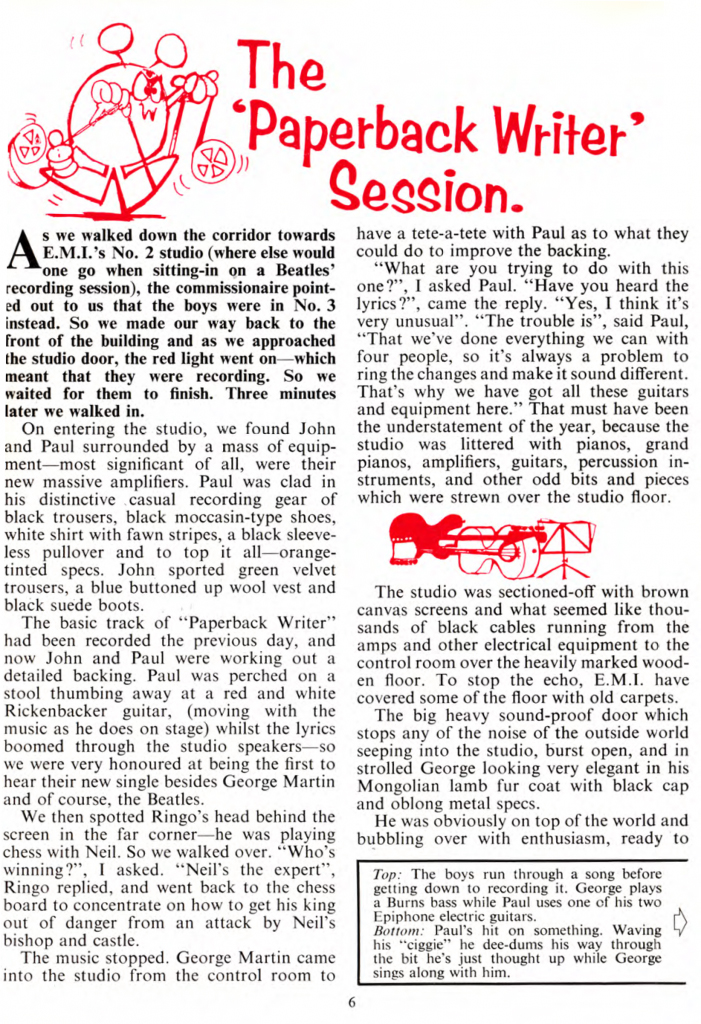
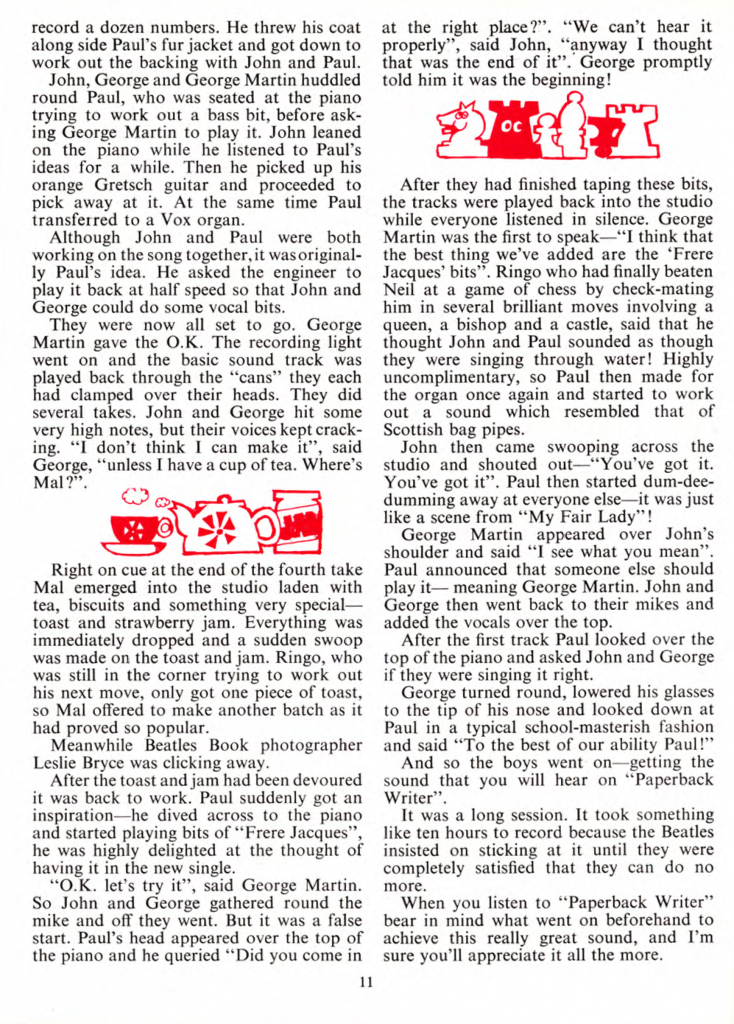
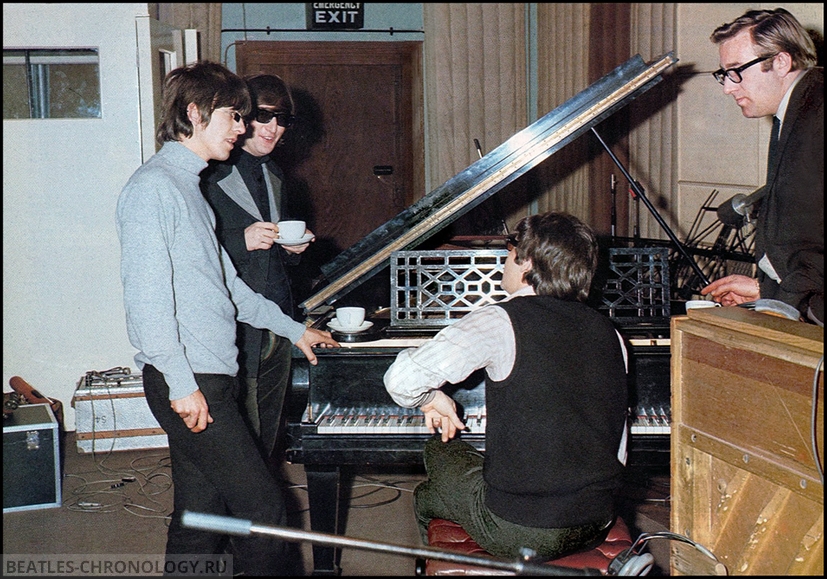
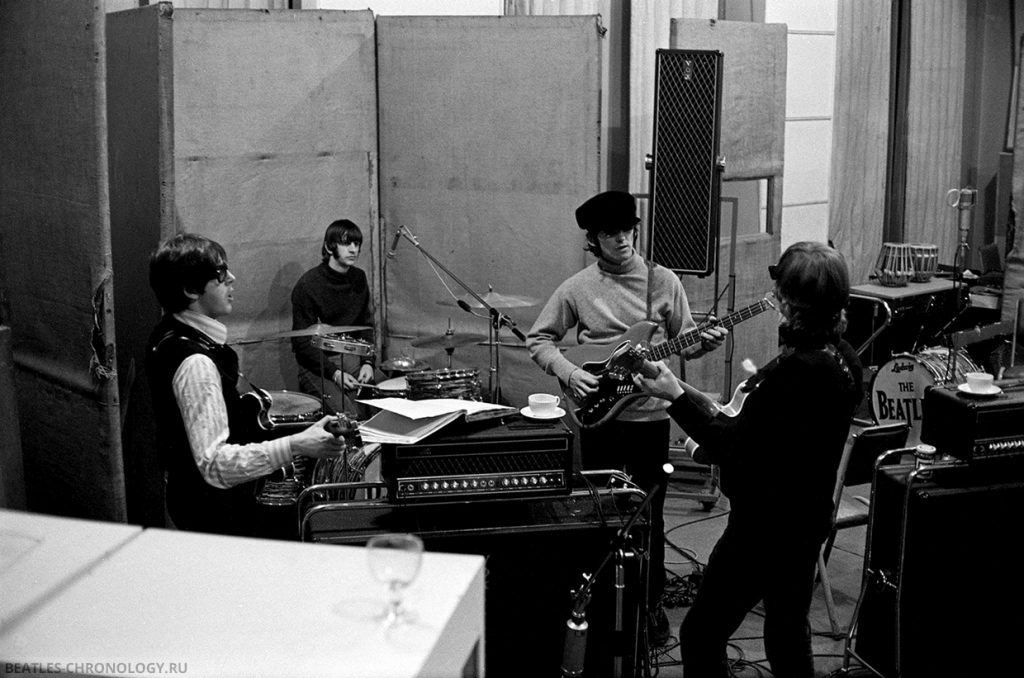
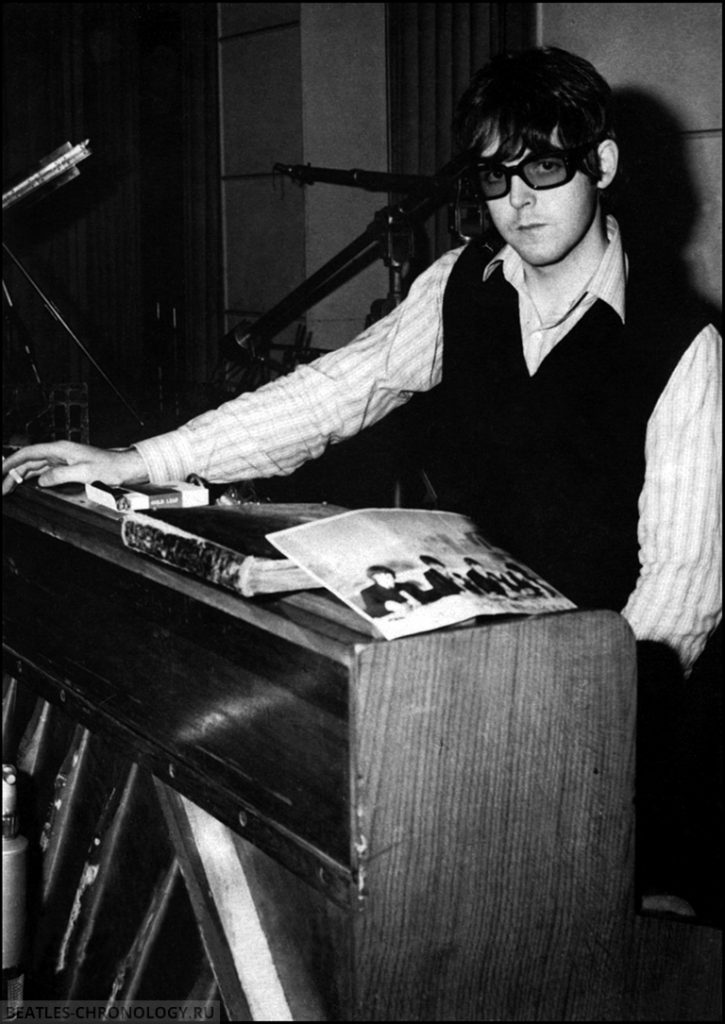
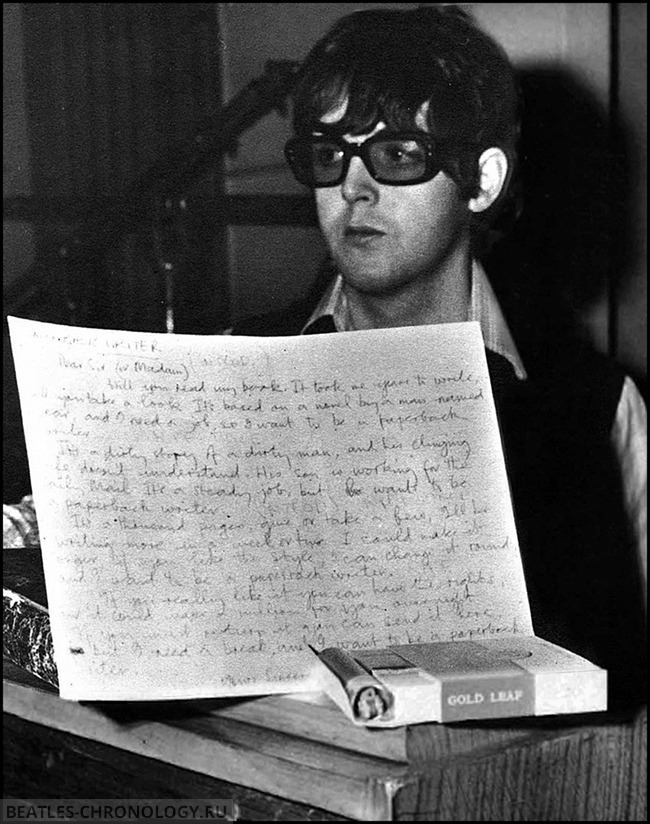
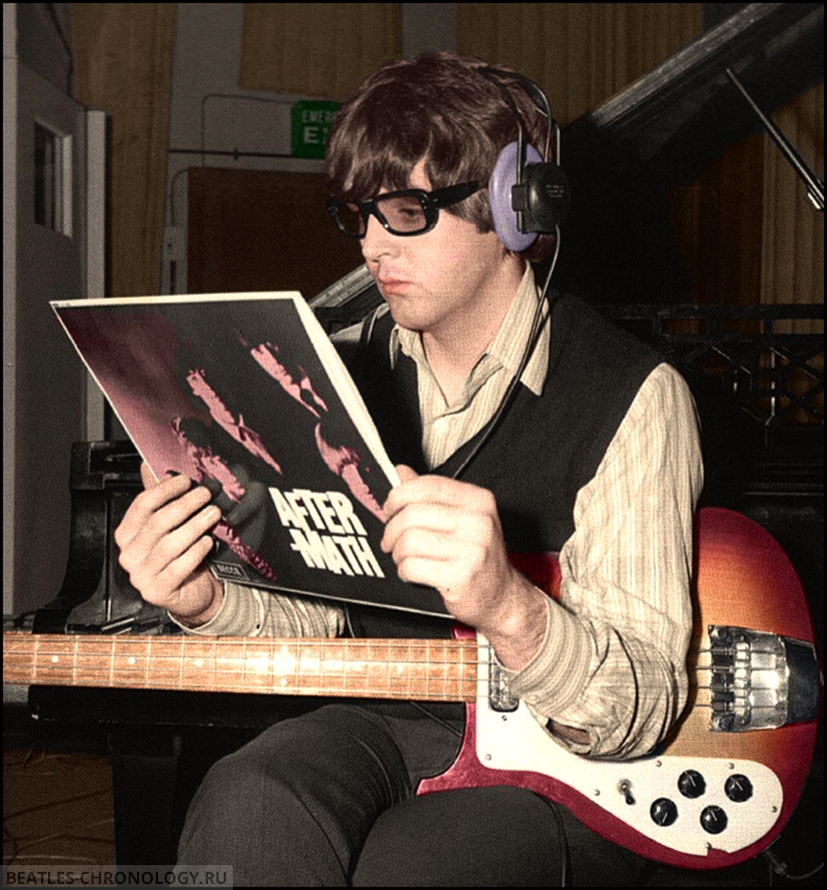
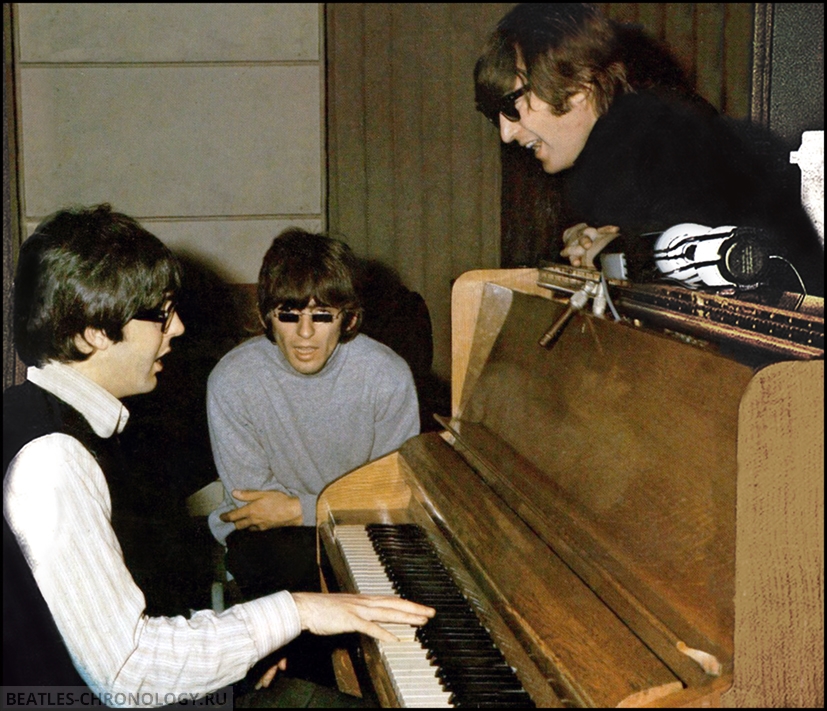
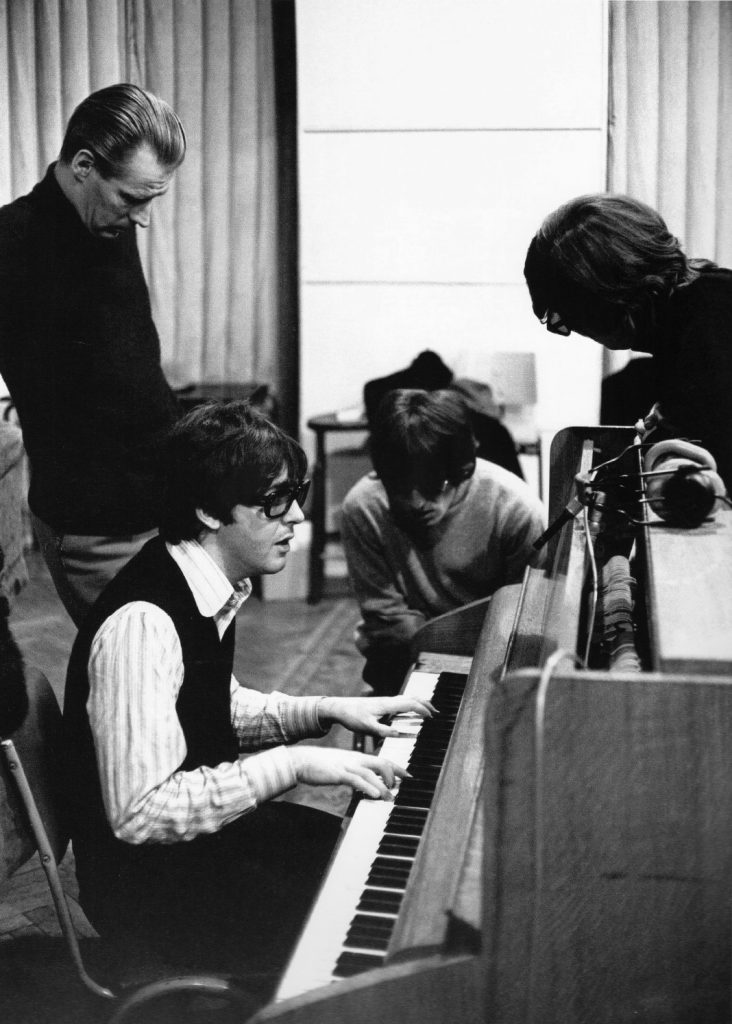
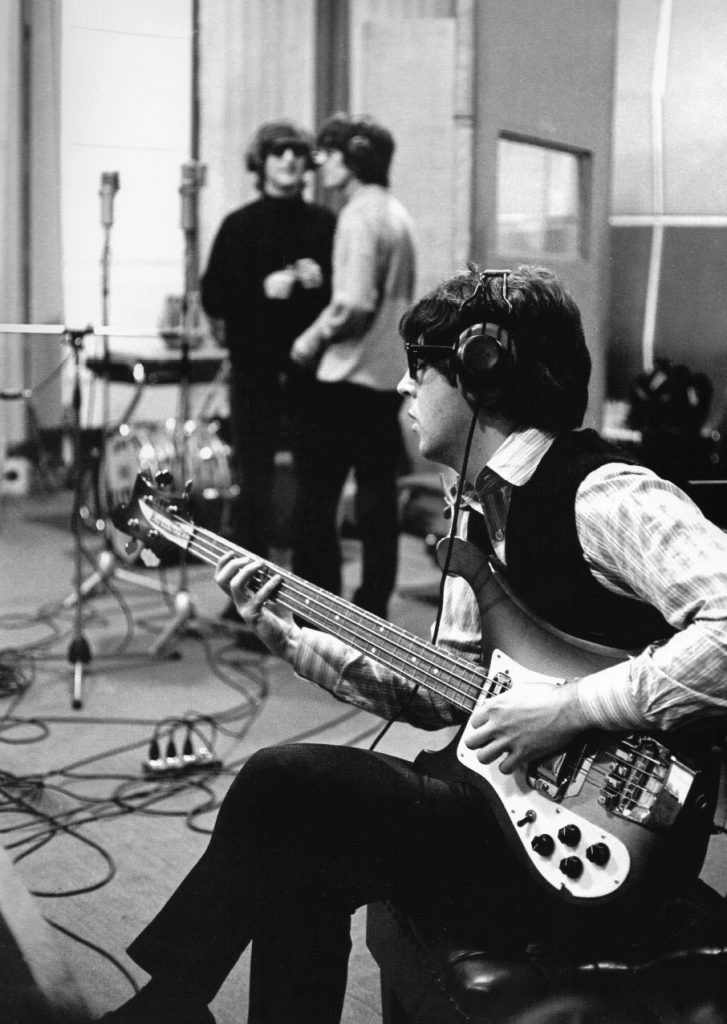




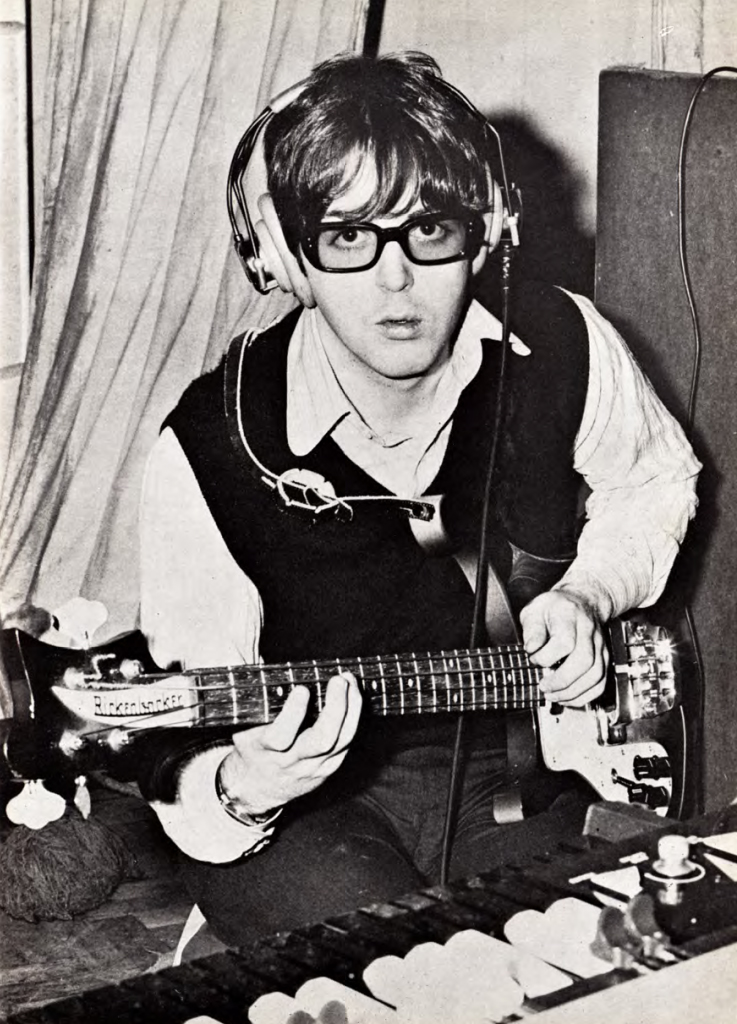
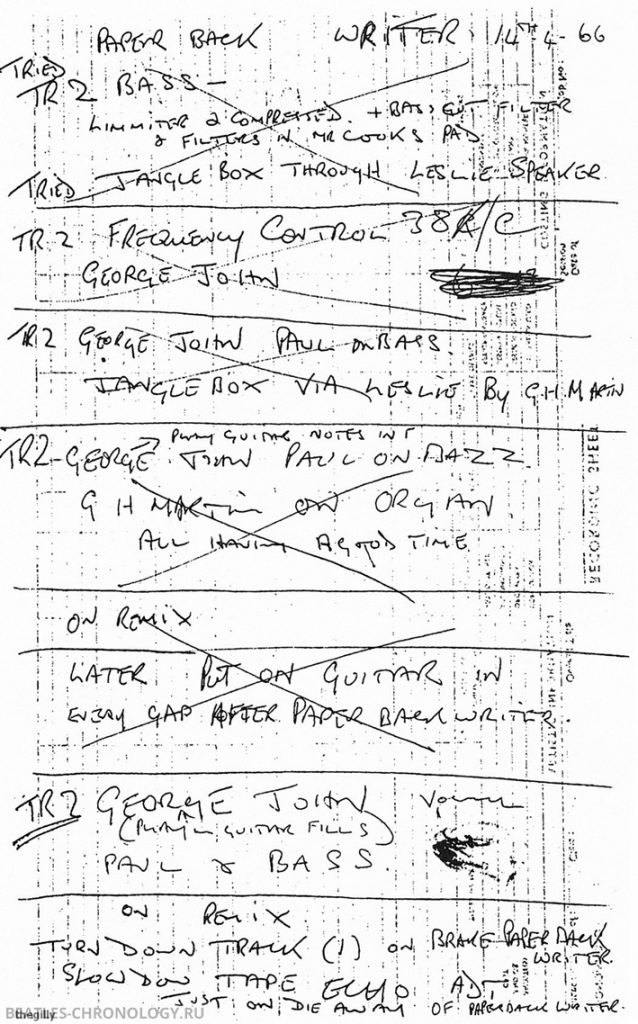
Recording • SI onto take 2
Mixing • Mono mixing - Remix 1 from take 2
Mixing • Mono mixing - Remix 2 from take 2
AlbumOfficially released on Paperback Writer / Rain (UK)
Recording • Take 1
Recording • Take 2
Recording • Take 3
Recording • Take 4
Recording • Take 5
AlbumOfficially released on Revolver (Super Deluxe - 2022)
Recording • SI onto Take 5
The Complete Beatles Recording Sessions • Mark Lewisohn
The definitive guide for every Beatles recording sessions from 1962 to 1970.
We owe a lot to Mark Lewisohn for the creation of those session pages, but you really have to buy this book to get all the details - the number of takes for each song, who contributed what, a description of the context and how each session went, various photographies... And an introductory interview with Paul McCartney!
The Beatles Recording Reference Manual - Volume 2 - Help! through Revolver (1965-1966)
The second book of the Association for Recorded Sound Collections (ARSC)-nominated series, "The Beatles Recording Reference Manual: Volume 2: Help! through Revolver (1965-1966)" follows the evolution of the band from the end of Beatlemania with "Help!" through the introspection of "Rubber Soul" up to the sonic revolution of "Revolver". From the first take to the final remix, discover the making of the greatest recordings of all time.
Through extensive, fully-documented research, these books fill an important gap left by all other Beatles books published to date and provide a unique view into the recordings of the world's most successful pop music act.
If we modestly consider the Paul McCartney Project to be the premier online resource for all things Paul McCartney, it is undeniable that The Beatles Bible stands as the definitive online site dedicated to the Beatles. While there is some overlap in content between the two sites, they differ significantly in their approach.

Notice any inaccuracies on this page? Have additional insights or ideas for new content? Or just want to share your thoughts? We value your feedback! Please use the form below to get in touch with us.
David Harvey • 1 year ago
Kevin Howlett’s liner notes for “Rain” were incorrect - George plays electric guitar on “Rain”, not Paul.
The PaulMcCartney Project • 1 year ago
Thanks for confirmation, David !